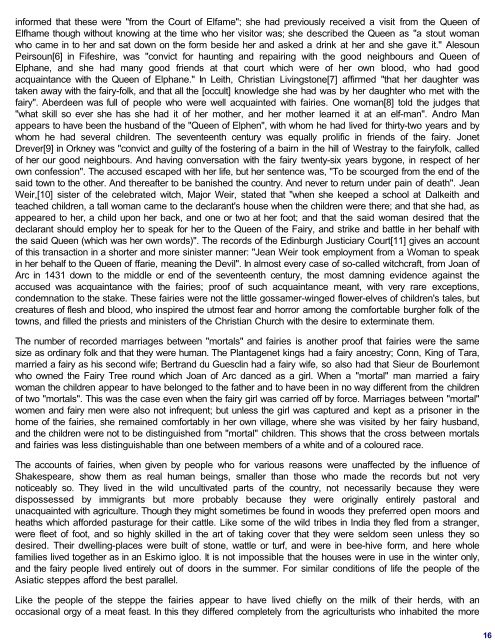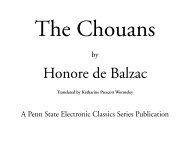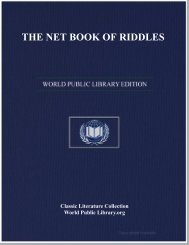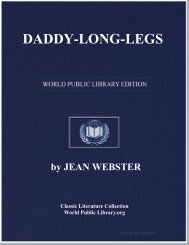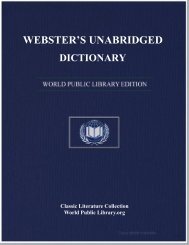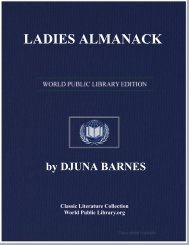THE GOD OF THE WITCHES - World eBook Library - World Public ...
THE GOD OF THE WITCHES - World eBook Library - World Public ...
THE GOD OF THE WITCHES - World eBook Library - World Public ...
Create successful ePaper yourself
Turn your PDF publications into a flip-book with our unique Google optimized e-Paper software.
informed that these were "from the Court of Elfame"; she had previously received a visit from the Queen of<br />
Elfhame though without knowing at the time who her visitor was; she described the Queen as "a stout woman<br />
who came in to her and sat down on the form beside her and asked a drink at her and she gave it." Alesoun<br />
Peirsoun[6] in Fifeshire, was "convict for haunting and repairing with the good neighbours and Queen of<br />
Elphane, and she had many good friends at that court which were of her own blood, who had good<br />
acquaintance with the Queen of Elphane." In Leith, Christian Livingstone[7] affirmed "that her daughter was<br />
taken away with the fairy-folk, and that all the [occult] knowledge she had was by her daughter who met with the<br />
fairy". Aberdeen was full of people who were well acquainted with fairies. One woman[8] told the judges that<br />
"what skill so ever she has she had it of her mother, and her mother learned it at an elf-man". Andro Man<br />
appears to have been the husband of the "Queen of Elphen", with whom he had lived for thirty-two years and by<br />
whom he had several children. The seventeenth century was equally prolific in friends of the fairy. Jonet<br />
Drever[9] in Orkney was "convict and guilty of the fostering of a bairn in the hill of Westray to the fairyfolk, called<br />
of her our good neighbours. And having conversation with the fairy twenty-six years bygone, in respect of her<br />
own confession". The accused escaped with her life, but her sentence was, "To be scourged from the end of the<br />
said town to the other. And thereafter to be banished the country. And never to return under pain of death". Jean<br />
Weir,[10] sister of the celebrated witch, Major Weir, stated that "when she keeped a school at Dalkeith and<br />
teached children, a tall woman came to the declarant's house when the children were there; and that she had, as<br />
appeared to her, a child upon her back, and one or two at her foot; and that the said woman desired that the<br />
declarant should employ her to speak for her to the Queen of the Fairy, and strike and battle in her behalf with<br />
the said Queen (which was her own words)". The records of the Edinburgh Justiciary Court[11] gives an account<br />
of this transaction in a shorter and more sinister manner: "Jean Weir took employment from a Woman to speak<br />
in her behalf to the Queen of ffarie, meaning the Devil". In almost every case of so-called witchcraft, from Joan of<br />
Arc in 1431 down to the middle or end of the seventeenth century, the most damning evidence against the<br />
accused was acquaintance with the fairies; proof of such acquaintance meant, with very rare exceptions,<br />
condemnation to the stake. These fairies were not the little gossamer-winged flower-elves of children's tales, but<br />
creatures of flesh and blood, who inspired the utmost fear and horror among the comfortable burgher folk of the<br />
towns, and filled the priests and ministers of the Christian Church with the desire to exterminate them.<br />
The number of recorded marriages between "mortals" and fairies is another proof that fairies were the same<br />
size as ordinary folk and that they were human. The Plantagenet kings had a fairy ancestry; Conn, King of Tara,<br />
married a fairy as his second wife; Bertrand du Guesclin had a fairy wife, so also had that Sieur de Bourlemont<br />
who owned the Fairy Tree round which Joan of Arc danced as a girl. When a "mortal" man married a fairy<br />
woman the children appear to have belonged to the father and to have been in no way different from the children<br />
of two "mortals". This was the case even when the fairy girl was carried off by force. Marriages between "mortal"<br />
women and fairy men were also not infrequent; but unless the girl was captured and kept as a prisoner in the<br />
home of the fairies, she remained comfortably in her own village, where she was visited by her fairy husband,<br />
and the children were not to be distinguished from "mortal" children. This shows that the cross between mortals<br />
and fairies was less distinguishable than one between members of a white and of a coloured race.<br />
The accounts of fairies, when given by people who for various reasons were unaffected by the influence of<br />
Shakespeare, show them as real human beings, smaller than those who made the records but not very<br />
noticeably so. They lived in the wild uncultivated parts of the country, not necessarily because they were<br />
dispossessed by immigrants but more probably because they were originally entirely pastoral and<br />
unacquainted with agriculture. Though they might sometimes be found in woods they preferred open moors and<br />
heaths which afforded pasturage for their cattle. Like some of the wild tribes in India they fled from a stranger,<br />
were fleet of foot, and so highly skilled in the art of taking cover that they were seldom seen unless they so<br />
desired. Their dwelling-places were built of stone, wattle or turf, and were in bee-hive form, and here whole<br />
families lived together as in an Eskimo igloo. It is not impossible that the houses were in use in the winter only,<br />
and the fairy people lived entirely out of doors in the summer. For similar conditions of life the people of the<br />
Asiatic steppes afford the best parallel.<br />
Like the people of the steppe the fairies appear to have lived chiefly on the milk of their herds, with an<br />
occasional orgy of a meat feast. In this they differed completely from the agriculturists who inhabited the more<br />
16


